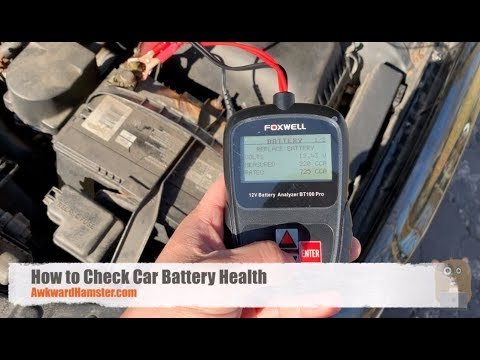How to Check a Car Battery’s Health
Want to know how to check a car battery’s health? Well, you’ve come to the right place! Taking care of your car’s battery is essential for ensuring a smooth and reliable ride. After all, no one wants to be stranded with a dead battery. In this article, we will walk you through a simple method to check your car battery’s health and give you some useful tips to keep it in top condition. So, let’s dive in and find out how to check a car battery’s health!
How to Check a Car Battery’s Health?
When it comes to the performance of your car, the battery plays a crucial role. A healthy battery ensures that your vehicle starts smoothly and runs efficiently. However, over time, batteries can deteriorate, leading to issues such as difficulty starting the car or frequent breakdowns. To avoid such inconveniences, it is essential to regularly check the health of your car battery. In this article, we will guide you through the process of checking your car battery’s health. By following these steps, you can identify any potential problems and take necessary actions to maintain or replace the battery, ensuring optimal performance and reliability.
Why is Checking Car Battery Health Important?
The battery is the heart of your car’s electrical system, supplying power to start the engine and run various components. By regularly checking your car battery’s health, you can:
- Prevent unexpected breakdowns: A weak or failing battery can leave you stranded at the most inconvenient times. By monitoring its health, you can detect potential issues early and address them before they escalate.
- Save money: Timely maintenance of your battery can help extend its lifespan. Regular checks can identify problems that may be fixable, avoiding the need for a costly battery replacement.
- Ensure optimal performance: A weak battery can affect the overall performance of your vehicle, including starting the engine and running electrical systems. By keeping the battery in good health, you can enjoy a smooth and reliable driving experience.
- Maximize battery life: By monitoring your battery’s health, you can take preventive measures to extend its lifespan. Proper maintenance and early detection of issues can help you get the most out of your battery.
Tools Needed to Check Car Battery Health
Before diving into the process of checking your battery’s health, it’s important to gather a few tools that will make the task easier. Here are the essential tools you will need:
- A pair of safety glasses: Protect your eyes from any potential battery acid splashes or debris.
- Gloves: Wear gloves to protect your hands from battery acid and to maintain a good grip.
- A battery tester or multimeter: This tool allows you to measure the voltage, current, and resistance of the battery.
- A battery load tester: This device helps determine the battery’s ability to perform under various load conditions.
- A battery charger: If your battery needs a charge, a charger will help restore its power efficiently.
- Baking soda and water: These household items are useful for cleaning the battery terminals if necessary.
Step-by-Step Guide to Checking Car Battery Health
Now that you have gathered the necessary tools, let’s dive into the step-by-step process of checking your car battery’s health:
1. Safety First
Before you begin, always prioritize safety. Follow these precautions:
- Park your car in a well-ventilated area.
- Wear safety glasses and gloves.
- Keep open flames or sparks away from the battery area.
- Ensure the engine and all electrical components are turned off.
2. Visual Inspection
Start by visually inspecting the battery for any physical damages or signs of corrosion:
- Check for cracks, bulges, or leaks in the battery casing.
- Inspect the battery terminals for corrosion or buildup.
- Ensure the battery cables are securely connected to the terminals.
If you observe any significant damages or leaks, it may be best to replace the battery entirely. If there is only minor corrosion, you can clean the terminals with a mixture of baking soda and water.
3. Testing Battery Voltage
One of the primary ways to determine your battery’s health is by measuring its voltage. Follow these steps:
- Make sure the engine and all electrical components are turned off.
- Attach the positive (red) multimeter lead to the positive terminal of the battery.
- Connect the negative (black) multimeter lead to the negative terminal of the battery.
- Set the multimeter to DC voltage mode and select the appropriate voltage range.
- Read and record the voltage displayed on the multimeter.
A healthy car battery, when fully charged, should display a voltage between 12.4 to 12.7 volts. If the voltage falls below 12.2 volts, it may indicate a weak battery that requires attention.
4. Conducting a Load Test
While voltage measurement provides valuable information, a load test gives a more accurate picture of your battery’s health. A load tester applies a controlled load to the battery to assess its performance. Here’s how to perform a load test:
- Ensure the engine and all electrical components are turned off.
- Connect the load tester terminals to the corresponding battery terminals.
- Follow the load tester manufacturer’s instructions to apply the load for the specified duration.
- Observe the load tester readings and compare them to the manufacturer’s recommendations.
If the load test results indicate a weak battery, it is a clear sign that the battery needs replacement.
5. Check for Parasitic Draw
Parasitic draw refers to the continuous power drain from the battery even when the car is not in use. This can lead to a discharged battery over time. To check for parasitic draw:
- Ensure the engine and all electrical components are turned off.
- Disconnect any aftermarket electrical devices.
- Set the multimeter to measure DC amps and select a low amp range.
- Connect the multimeter in series with the negative battery cable.
- Wait for any initial electronic system power-down, and then observe the multimeter reading.
A reading above 50 milliamps (mA) typically indicates a parasitic draw and may require further investigation by a professional.
6. Battery Charging
If your battery appears to be weak or has a low voltage reading, it may require charging. Follow these steps to charge your battery:
- Refer to the manufacturer’s instructions for your battery charger.
- Ensure the charger is unplugged before connecting it to the battery.
- Connect the charger’s positive clamp to the battery’s positive terminal.
- Connect the charger’s negative clamp to the battery’s negative terminal.
- Follow the charger’s instructions for selecting the appropriate charging mode.
- Plug in the charger and allow it to charge your battery fully.
- Once fully charged, disconnect the charger and remove the clamps from the battery terminals.
Regularly checking your car battery’s health is essential for maintaining its performance and ensuring a reliable driving experience. By following the step-by-step guide provided in this article, you can easily assess the condition of your car battery and take necessary actions to prolong its life or replace it if needed. Remember, a healthy battery not only guarantees the smooth operation of your vehicle but also saves you from unexpected breakdowns. Take care of your battery, and it will take care of you on the road ahead!
How to test a car battery
Frequently Asked Questions
How do I check the health of my car battery?
To check the health of your car battery, you can perform a simple voltage test using a multimeter. First, make sure the engine is off and the vehicle is parked in a safe location. Connect the positive (red) probe of the multimeter to the positive terminal of the battery, and the negative (black) probe to the negative terminal. The multimeter should display the battery’s voltage, which should ideally be around 12.6 volts for a fully charged battery. Anything below 12 volts may indicate a weak or discharged battery that requires charging or replacement.
What should I do if my car battery’s voltage is low?
If your car battery’s voltage is below the recommended threshold of 12 volts, it is likely in a low-charge state. Start by charging the battery using an appropriate battery charger. Follow the instructions provided with the charger to ensure safe and proper charging. If the battery repeatedly discharges quickly after charging, it may be time to replace it with a new one.
Can I visually inspect my car battery to check its health?
Yes, you can visually inspect your car battery to check for any signs of damage or corrosion. Look for any cracks or leaks on the battery casing, as these can indicate a faulty or failing battery. Additionally, check the battery terminals for any corrosion buildup. Corrosion can hinder the flow of electricity and affect the battery’s performance. If you notice any significant damage or excessive corrosion, it is advisable to have the battery inspected or replaced by a professional.
Are there any specific tests to determine a car battery’s health?
Yes, apart from the voltage test, there are a few other tests you can perform to assess the health of your car battery. One such test is a load test, which measures the battery’s ability to deliver power under a load. This test requires specialized equipment and is usually performed by professionals. Another test is the specific gravity test, which involves measuring the density of the battery’s electrolyte. However, this test is applicable mainly for certain types of batteries and may not be suitable for all vehicles.
How often should I check the health of my car battery?
It is recommended to check the health of your car battery at regular intervals. A good practice is to include it in your routine vehicle maintenance checks, such as during oil changes or tire rotations. Additionally, if you notice any signs of battery-related issues, such as slow engine cranking or dim headlights, it is advisable to check the battery’s health promptly.
Can extreme temperatures affect a car battery’s health?
Yes, extreme temperatures can have a significant impact on a car battery’s health. Both extremely hot and extremely cold temperatures can affect the battery’s capacity and overall performance. In hot weather, excessive heat can cause the battery fluid to evaporate, leading to internal damage. Cold temperatures, on the other hand, can reduce a battery’s ability to deliver power effectively. It is crucial to protect your car battery from extreme temperatures and ensure proper maintenance to prolong its lifespan.
Final Thoughts
In conclusion, checking a car battery’s health is vital for ensuring its optimal function and preventing unexpected breakdowns. By performing simple tests such as voltage measurement and visual inspection, drivers can assess the battery’s overall condition. Additionally, keeping track of maintenance and usage history provides valuable insights into the battery’s longevity. Regularly monitoring the battery’s health and addressing any issues promptly can contribute to a smoother driving experience and avoid inconvenient situations on the road. Remember, taking proactive steps to evaluate and maintain a car battery’s health is crucial for optimizing its performance and prolonging its lifespan.


